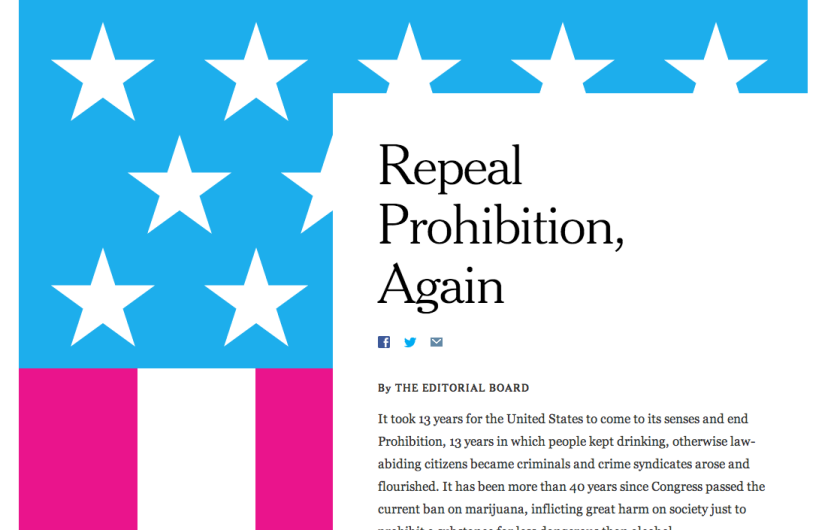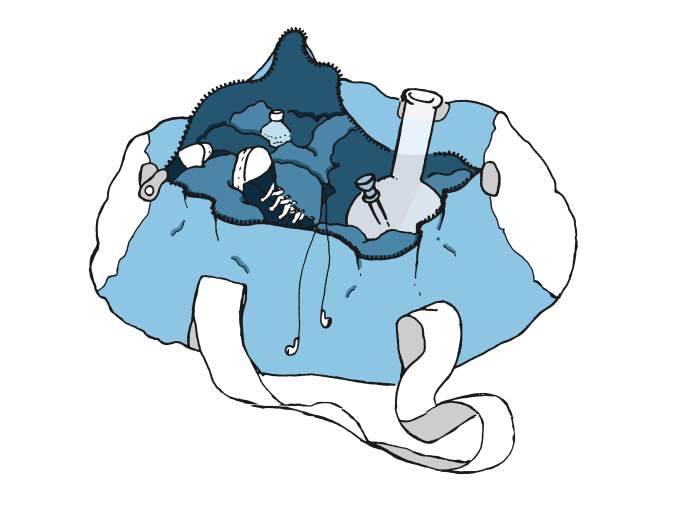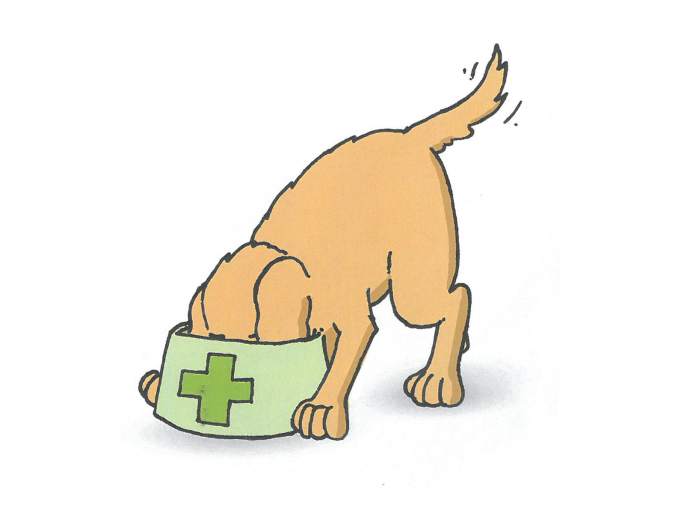About the Author
A Gonzo journalist hailing from New York City, Gonzo has contributed to pretty much every marijuana magazine and blog in the nation. He covers Medicinial, Growing and National News for Higher Ground. And since it’s not legal where he lives, he’ll remain anonymous. For now.You Might also like
-
New York Times Endorses Legalization
By THE EDITORIAL BOARD
It took 13 years for the United States to come to its senses and end Prohibition, 13 years in which people kept drinking, otherwise law-abiding citizens became criminals and crime syndicates arose and flourished. It has been more than 40 years since Congress passed the current ban on marijuana, inflicting great harm on society just to prohibit a substance far less dangerous than alcohol.
The federal government should repeal the ban on marijuana.
We reached that conclusion after a great deal of discussion among the members of The Times’s Editorial Board, inspired by a rapidly growing movement among the states to reform marijuana laws.
There are no perfect answers to people’s legitimate concerns about marijuana use. But neither are there such answers about tobacco or alcohol, and we believe that on every level — health effects, the impact on society and law-and-order issues — the balance falls squarely on the side of national legalization. That will put decisions on whether to allow recreational or medicinal production and use where it belongs — at the state level.
We considered whether it would be best for Washington to hold back while the states continued experimenting with legalizing medicinal uses of marijuana, reducing penalties, or even simply legalizing all use. Nearly three-quarters of the states have done one of these.
But that would leave their citizens vulnerable to the whims of whoever happens to be in the White House and chooses to enforce or not enforce the federal law.
The social costs of the marijuana laws are vast. There were 658,000 arrests for marijuana possession in 2012, according to F.B.I. figures, compared with 256,000 for cocaine, heroin and their derivatives. Even worse, the result is racist, falling disproportionately on young black men, ruining their lives and creating new generations of career criminals.
There is honest debate among scientists about the health effects of marijuana, but we believe that the evidence is overwhelming that addiction and dependence are relatively minor problems, especially compared with alcohol and tobacco. Moderate use of marijuana does not appear to pose a risk for otherwise healthy adults. Claims that marijuana is a gateway to more dangerous drugs are as fanciful as the “Reefer Madness” images of murder, rape and suicide.
There are legitimate concerns about marijuana on the development of adolescent brains. For that reason, we advocate the prohibition of sales to people under 21.
Creating systems for regulating manufacture, sale and marketing will be complex. But those problems are solvable, and would have long been dealt with had we as a nation not clung to the decision to make marijuana production and use a federal crime.
In coming days, we will publish articles by members of the Editorial Board and supplementary material that will examine these questions. We invite readers to offer their ideas, and we will report back on their responses, pro and con.
We recognize that this Congress is as unlikely to take action on marijuana as it has been on other big issues. But it is long past time to repeal this version of Prohibition.
http://www.nytimes.com/interactive/2014/07/27/opinion/sunday/high-time-marijuana-legalization.html?_r=3&smid=tw-share
-
Higher Ground: Runner’s High
Spring has sprung, and it’s finally time to strap on the running shoes and get stoned out of your mind!There’s no doubt that marijuana is good for all kinds of things: stimulating the appetite, creative brainstorming, giggle-fests . . . but exercise? Yes, apparently. According to an article in last month’s Runner’s World, athletes who use cannabis benefit from stress relief and reduced inflammation.
Now I’m no marathoner, but I do understand the pain and nausea that kind of grind might cause; hell, I “hit the wall” on walks from Starbucks to the car. And long-distance runners are now claiming that the pain relief associated with marijuana is also a huge benefit for their grueling efforts, helping athletes achieve an idealized state earlier in their run.
“When you have runner’s high, you have feelings very similar to those you would feel if you were smoking marijuana,” stated neuroscientist Arne Dietrich in Runner’s World. The prefrontal cortex of the brain regulates both feelings, Dietrich notes, including “sedation, analgesia, mild happiness, the loss of the sensation of time, and a loss of worries.” What? Where was I?
It makes sense that the CBDs that help to block the input of pain for medicinal purposes and act as anti-inflammatories can also help athletes struggling with joint pain in various sports. And we’re not just talking about snowboarders or Ultimate Frisbee Golf jocks either. A Wall Street Journal story recently interviewed ultra-marathon runners, who run up to 200 miles over 20-hour periods, and many noted that cannabis aids with the stomach cramps and intense muscle pain they endure along the way. “The person who is going to win an ultra is someone who can manage their pain, not puke, and stay calm,” said veteran runner Jenn Shelton. “Pot does all three of those things.” I have a better suggestion for these masochistic ultra-marathoners: moderation!
Even the World Anti-Doping Agency and U.S. Track & Field are coming around on dope. Last year the WADA raised the acceptable amount of THC a runner can have in his or her system, flagging only runners who use pot on the day of competition. Using marijuana during training sessions or as a sleep aid the night before a race is all good. There’s a reason the fastest man on the planet, Usain Bolt, is from Jamaica, mon!
Running high as a kite is not for everyone. Chronic smoking has been related to pulmonary irritation and symptoms of chronic bronchitis (including hocking loogies). “There are cardiovascular effects, like increasing heart rate,” says Gregory Gerdeman (The Pot Book) in the Runner’s World piece. “These may be minimal in young athletes or those with tolerance, but should be considered seriously by anyone at risk for coronary heart disease. Plus, there have been some studies that suggest it influences blood flow to the brain, which can influence the risk of stroke.”
Still, cannabis smoking doesn’t have nearly the negative effect on the lungs that tobacco does. The National Institutes of Health did a study in 2013 that I wish I’d been chosen for. They exposed a group of adults to up to seven “joint years”—one joint per day for seven years—and found that even those extremes didn’t diminish lung function. In fact, marijuana users in the study performed a little better than nonsmokers on a lung-function test, because ganja smokers were basically “training” over time by taking deep breaths and holding smoke in.
Outside did its own piece on stoned running (“Know Before You Go!”), and, while not condoning the practice, gave helpful tips, including not getting lost, bringing munchies along the way, and “dosing” in a safe environment: “You don’t want to be 10 miles into the mountains and suddenly feel like you need to take a nap because THC makes you sleepy, then find yourself dozing off in the middle of the woods with no food or shelter.” Their advice on dosing was a little . . . high: “While lower doses often lead to a relaxed physical state and sense of well-being, or a ‘body high,’ high doses can bring on an acid-trip type of experience with hallucinations and possible paranoia. Once the drug kicks in, the high can last from four to 10 hours, or possibly longer.” Not sure where they’re getting their ganja, but I want some. Wow!
My own advice is to use marijuana as a sort of reward after you exercise. The perfect indulgent treat? The CannaBar! It’s a protein candy bar made using almonds, honey, and hemp-based cannabidiols—with less fatty ingredients that the Clif bars you’re shakily shoving in mid-marathon. Sadly, the CannaBar is made with a cannabis sativa without much THC, so it doesn’t get you high; you’ll want to do that in the traditional way—and by that I mean taking off your Brooks, collapsing on the couch, and sucking down bong hits.
This article first appeared in the Seattle Weekly. -
Higher Ground: Pot for Pets
Can weed give our furry companions happier lives and more peaceful deaths?
Remember the right-wing homophobes who claimed that if we allowed gays to get married, pretty soon people would begin marrying their pets? Well, now, the damn hippies who voted to legalize the wacky weed are indeed trying to get their dogs and cats stoned! Hooked on the hound hemp! The kitty chronic!?Companies like Seattle-based Canna-Pet and Canna Companion sell cannabinoid treats for dogs and cats—not to get them high (the hemp biscuits and capsules have very low levels of THC), but to help with joint discomfort and inflammation, and hopefully to make that yappy poodle across the street calm the fuck down.
Recently the Food and Drug Administration began cracking down on pooch-pot peddlers for some of the claims made in their marketing materials. The FDA wants phrases like “anti-cancer” and “anti-tumor” taken off Canna-Pet’s packaging, as those medical claims have not been proven.
Canna Companion, from Snohomish County, says their products are all-natural, and inhibit cancer-cell growth and reduce inflammation. Clinical trials monitored by the FDA haven’t taken place, because of course at the federal level, the testing or sale of marijuana is a felony offense—not to mention it’s hard to get Fido to fill out the post-trial questionnaire. Cats are better at giving feedback, but are prone to hissy fits in the comments section.
Similar to humans, domesticated animals have endocannabinoid systems and can potentially be physically and psychologically aided by ingesting cannabis. While industrial hemp hasn’t been proven as a puppy painkiller, many vets and owners have had success using the stuff to help pets gain weight after sicknesses and surgery, as well as to provide pain relief during end-of-life stages. Los Angeles veterinarian Doug Kramer told the Associated Press that he’s had more than 300 patients use cannabis to help everything from infections to separation anxiety to feline immunodeficiency virus to irritable-bowel syndrome (which I thought was the very definition of being a pet). Talk about skunk weed!
After giving his husky, Nikita, cannabis oils for her terminal cancer, Dr. Kramer said she gained weight and was able to live an extra six pain-free weeks before having to be euthanized. “I grew tired of euthanizing pets when I wasn’t doing everything I could to make their lives better,” Kramer noted. “I felt like I was letting them down.”
Things are going a bit too far in Nevada, where, as part of a bill to overhaul their medical-marijuana laws, state Senator Tick Segerblom proposed a Pot-for-Pets provision that would require animal owners to apply for medical-marijuana cards. Cards would be issued only if a vet wrote a detailed description of how Count Flufferton’s condition might be aided with Puppy Chow Dank. Good Lord, it’s hard enough for folks to clean up after their pets, much less register them for a Canine Cannabis Card. Feed ’em all the Purina Cheeba ya want, as far as I’m concerned—just pick up the poop!
Veterinarians agree that feeding a pet straight marijuana or blowing pot smoke in Mr. Bigglesworth’s snout is never a good idea; most companies marketing for pets are using all-natural hemp treats, cannabis oils, and glycerin tinctures that can be put into the water bowl.
Not surprisingly, People for the Ethical Treatment of Animals has something to say on the matter. “Our position is that anything that can help animals,” stated President Ingrid Newkirk, “if it’s truly, properly administered in the right amount and can relieve a dog’s pain—then they should be given the same consideration that humans in pain are given.” (No comment on whether PETA gives ganja to the tens of thousands of pets they euthanize at their shelters after not finding homes for the non-rescued souls . . . )
While weed’s not a cure-all for everything; it’s also not gonna kill you (or your chronic companion). My neighbor’s golden retriever, Bailey, not only drank half a gallon of paint I had (stupidly) left out one summer day, but also chowed the brush and sponge inside it. She hurled a lovely shade of Benjamin Moore chartreuse-green for a week, but went on to live—and crap in my yard—for another decade. The bottom line is this: I don’t care if Snoopy gets high as the Red Baron on Snoop Dog Bud-Bones, just keep that pooch away from my personal stash. The steak’s for me. Lassie gets the leftovers.
This article first appeared in the Seattle Weekly.





